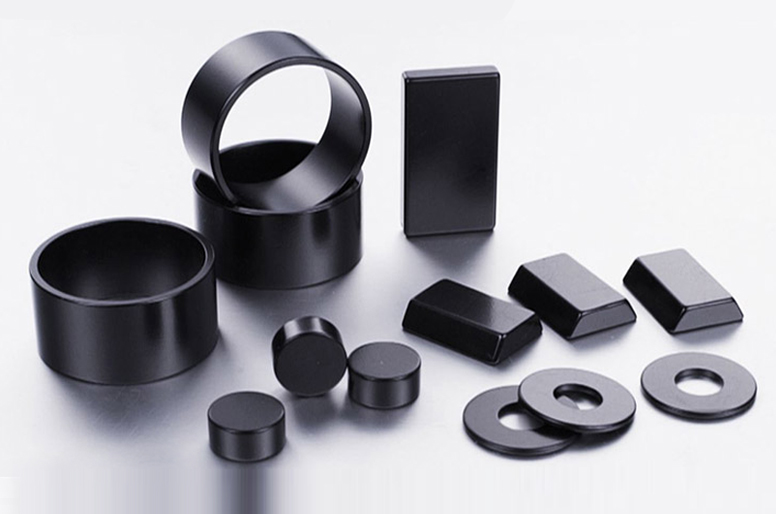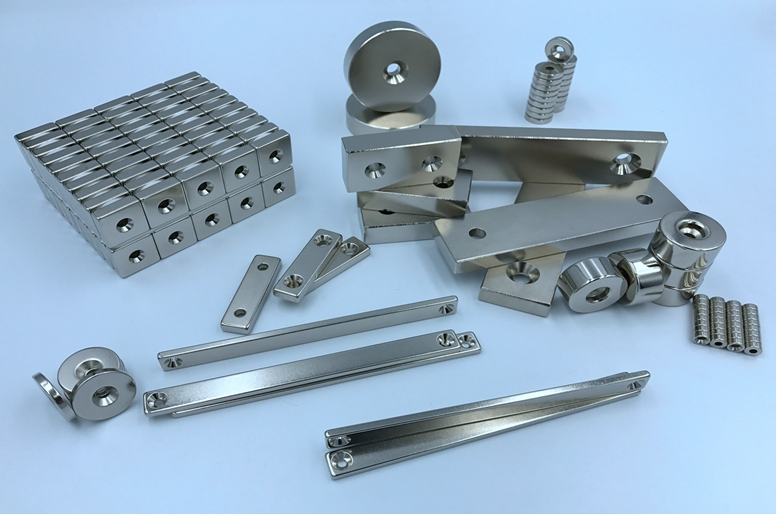0769-23388351
Toggle Navigation
Regarding the difference between bonded neodymium magnets and sintered neodymium magnets, there are many online introductions, why continue to provide this article? The main reason is that most of the introductions on the Internet are not comprehensive. Next, I will give a comprehensive introduction to the difference between sintered NdFeB and bonded NdFeB, and see their appearance, production and processing technology, density, magnetic force, surface treatment, and magnetization. What are the specific differences in terms of methods and prices?
First of all, let’s compare the appearance, can you see it by looking at the pictures without reading the introduction?”
Main shape picture of bonded neodymium magnet;

Bonded neodymium magnets usually have a black epoxy surface, with black or gray predominate.
The main shape picture of rare earth neodymium magnet;

Sintered neodymium magnets are usually galvanized or nickel-plated, with a silver-white appearance, and can also be epoxy-plated.
Comparison of production and processing technology of sintered and bonded neodymium magnets
Bonded NdFeB magnets are made by adding NdFeB magnetic powder to a binder. Bonding is actually injection molding. There are four main processing methods, namely calendering, injection molding, extrusion molding, and compression molding. Commonly used It is injection molding and compression molding. Compression molding is to mix magnetic powder and adhesive according to the proportion, after granulation and adding a certain amount of coupling agent, compression molding in the mold, curing at 120°~150°, and finally the finished product is obtained. . Using solid epoxy resin or phenolic resin, the addition amount is 1%~5%, and the permanent magnets can be bonded according to larger size and simple shape. Generally, cathodic electrophoresis, spraying, evaporation and other methods are used for coating protection.
Sintered NdFeB is formed by vacuuming and heating at high temperature. Generally, only blanks can be produced after sintering, and then through mechanical processing (such as wire cutting, slicing, grinding, etc.), they can become magnets of various shapes.
Bonded sintered neodymium magnet density difference;
The density of bonded NdFeB is about 6 g/cm3. The density of sintered NdFeB is about 7.5 g/cm3.
Magnetic difference between bonded and sintered neodymium magnets
The bonded NdFeB material contains less neodymium, so the performance is not as high as that of sintered NdFeB [Generally, the magnetic rings with relatively thin walls are bonded with NdFeB]
Price comparison of sintered neodymium magnets and bonded neodymium magnets;
The price of bonded NdFeB will be much cheaper. The specific price is due to the recent material fluctuations. Welcome to contact the business for consultation. The production of bonded NdFeB requires opening a mold, while sintered NdFeB does not.
Main shape difference;
Sintered neodymium magnets have a wider range of shapes, such as annular, round, square, cube, arc, with hole type, special-shaped and so on.
Bonded neodymium magnets are mainly ring-shaped, and can also be made into a square, circular arc, etc.
Magnetization method difference;
Bonded neodymium magnets are mainly based on multi-pole magnetization, such as radial multi-pole, axial multi-pole, View the magnetization direction and schematic diagram of the bonded neodymium magnet; https://www.dgcourage.com/xinwen/hyxw/308.html
Sintered neodymium magnets are generally magnetized, such as axial, radial, thickness, etc.
Application difference;
Sintered neodymium magnets are mainly used in electronics, motors, electrical appliances, electroacoustics, optical instruments, medical equipment, smart home, packaging handbags, toys, industry, health care and many other fields.
Bonded neodymium magnets are mainly used in permanent magnet motors and sensors in the fields of IT and office automation, smart home appliances, and automobiles.
The above is the introduction about bonded vs sintered neodymium magnets. If you have any questions, please contact us to inform you of the problems you encounter.
Other relevant articles;
Is the magnet used in the speaker sintered NdFeB or bonded NdFeB?
As shown in the picture, this product is a half-ring segmented magnet, standard half-ring shape, 2 half-ring can be put together to form a circle, the material is rare earth neodymium, with super strong magnetism, according to the customer's requirements, this half-ring magnet in the inner diameter of the larger R angle....
Have you ever seen this 10-sided magnet? I guess not. This is a 10-bar circular hole magnet with magnetized thickness, produced by China magnet supplier Guowei Magnet. The material of the magnet is rare earth neodymium, which belongs to customized special neodymium magnet, which can be used in industry, mechanical parts and electronic parts. We can also process the neodymium strong magnetic in the size and shape you want according...
This sample is a semi-circular neodymium magnet, the performance grade is N40, the maximum working temperature is 80 ℃, the surface coating is nickel-copper-nickel, the appearance is silver-white, and the size can be customized. Industry experience, drawings and samples are customized according to industry needs, quality is guaranteed...
This product is wind turbine magnet, the material is rare earth neodymium, the shape is trapezoidal, fan-shaped, arc section, the surface is galvanized, there is also a hole processed in the magnet (countersunk screw holes), belongs to the customized shape of the motor class magnets, such as you have specific requirements, such as the size, performance, temperature and other requirements can be contacted to provide you with quotations, prototyping and other services....
This is an ultra-small ferrite block magnet, small and thin, with a thickness of only 0.8mm, a length of 3.8mm, and a width of 2mm. It is mainly used for precision electronics, Hall sensors, and is magnetized in the direction of 2. The strong magnetic surface is the length If you are interested in this kind of small ferrite magnets, you can contact us to customize without pressure!...
This is the courage magnet manufacturer to provide you with a anisotropy multi-pole ferrite ring magnet, through the side (radial) 12 pole magnetization, the surface magnetic is about 1050 gauss, its size is 28.4mm outer diameter, 17.5mm inner hole, thickness of 4mm...
This product is a ring-shaped ferrite magnet with an outer diameter of 20mm, an inner diameter of 10mm, and a thickness of 3mm. There is no coating on the outside. The magnetizing method is axial/planar 4 poles and the surface magnetic field strength is about 980gs. If you are interested in this magnet, please contact We provide you with samples, and other specifications are needed. We can also provide you with more magnetic poles....
Sample shot is a small and thin radial neodymium magnet ring, belongs to rare earth magnets, zinc-plated surface, outer diameter 6.5mm, inner hole diameter 3.5mm, thickness 0.5mm, through the diameter of the direction of the magnetization...